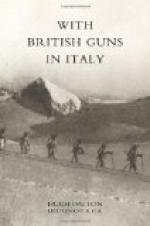Marostica charmed me even more. Its battlemented walls are like those of Cittadella and Castelfranco, but in a better state of preservation and more picturesque, running up a rocky foothill behind the town and coming down again,—a most curious effect. These Alpine foothills for shape and vegetation are very like the Ligurian hills north of Genoa and round Arquata.
At San Trinita, just outside Bassano on the road to Marostica, is a very fine cypress avenue. There was a possible Battery position here. I noticed also a row of cypresses standing at intervals of about fifty yards along a hillside, dark and tall amid a mass of grass and rocks and brown fallen leaves. The weather was clear and cold, but the snow had shrunk to subnormal on the foothills. The Weather God was still favouring the enemy. It was very still, though occasionally shells burst over the Grappa. But the hills muffle the sounds beyond them.
On the way back we passed a Battalion of Alpini marching up, many of them very young. I thought of the Duke of Aosta’s latest message to the undefeated Third Army: “A voi veterani del Carso, ed a voi, giovani soldati, fioritura della perenne primavera italica."[1] Splendid Alpini! They are never false to their regimental motto, “di qui non si passa!"[2] They never fail. But nearly all the first Alpini, who went forth to battle in May 1915, are dead now.
[Footnote 1: “To you, veterans of the Carso, and to you, young soldiers, flower of the eternal Italian spring.”]
[Footnote 2: “No one passes here!”]
On the 20th I went out in a side-car with Winterton to look for positions in the hills above Marostica. Reconnaissances of the back lines were now to be discontinued, a sign, we hoped, of diminishing apprehension and an improving military situation. At San Trinita on the way back we collided with an Italian wagon and had to stop for repairs. A number of Italians gathered round, one of whom I discovered to be a priest, conscribed to serve with the Medical Corps. I bantered this man in a friendly way about secret drinking and the confessional and women and paradise, causing uproarious delight among the bystanders. And the priest took it all in excellent part.
On the 22nd we heard that, irrespective of the movements of the rest of the Corps, a special Group of Heavy Artillery was to be formed, including ourselves, to be lent to the Italian Fourth Army in the mountains. There began to be rumours of an offensive on our part.
On the 23rd we made a reconnaissance up the mountains to look for positions. We started through Bassano, which the Austrians had begun to shell the day before with long range guns, starting a trickling, pitiful exodus of terrified civilians. Just before reaching Marostica we struck up a valley running northwards past Vallonara. The road soon began to rise more steeply. It was a war road, broad and of splendid surface, one of those many achievements of the Italian




